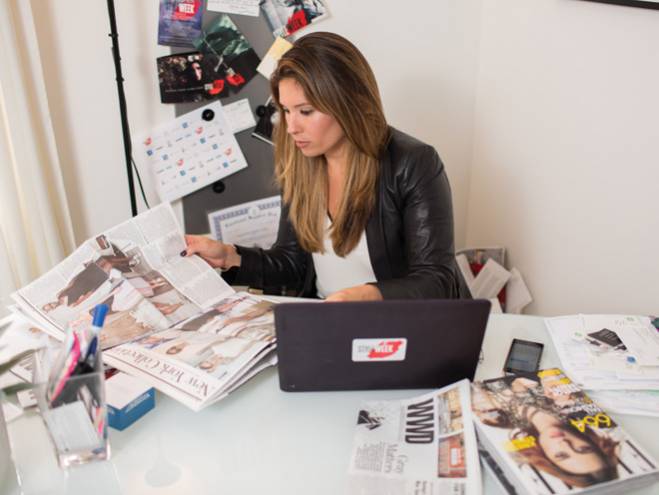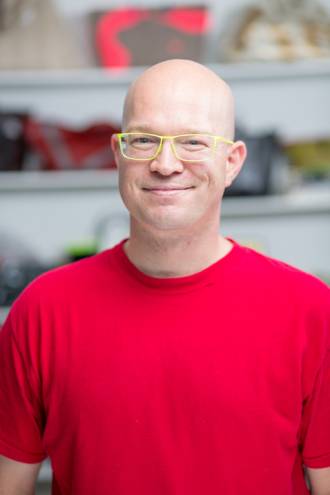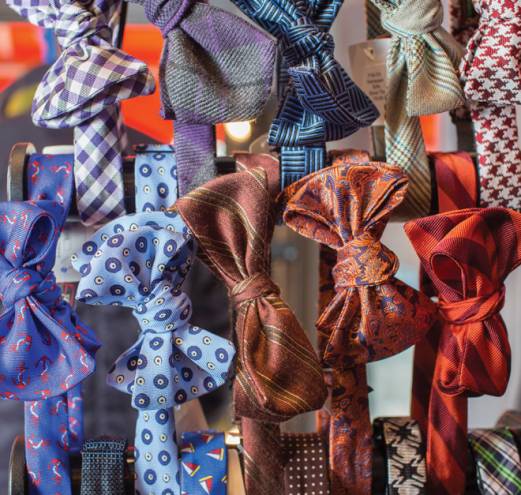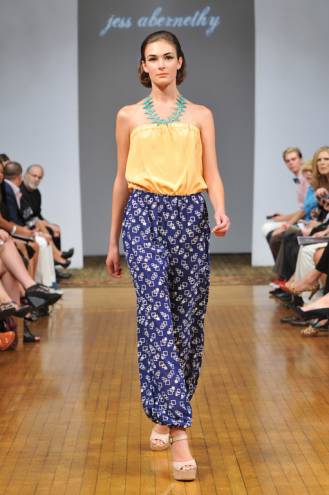We’re having a fashion moment in Providence. Like our other eras before - when the city was known first for its jewelry industry, or for noise music – this is a time we’re going to look back on and say “there was really something special happening there.” Think about it. We have twice-yearly fashion shows, universities turning out graduates with degrees in everything from apparel design to fashion merchandising, a designer co-op in the Arcade, local retailers carrying Rhode Island-made clothing, designers wholesaling their clothing and handbags all over the world. Yes, we’re having a fashion moment in Providence. But it’s not big enough. Too many budding talents are still bartending to make ends meet, and too few people in the city are wearing local designs. With the mayoral candidates promising to capitalize on the arts community to bolster our flagging economy, it’s time to think about fashion as Providence’s next growth industry. So what is it going to take to make that happen?
The Runway is Just the Beginning
“People forget that fashion’s not fashion without business,” says StyleWeek founder and CEO Rosanna M. Ortiz. “It’s a business. If you’re really in the fashion industry, you’re working all the time.” While StyleWeek, the biennial fashion showcase that’s a week of runway shows and shopping events, is a huge stepping stone for a new designer, too often a budding designer won’t know what to do with the possibilities the event affords. When it’s over, and after the newspaper coverage and social media buzz have died down, they don’t know how to keep the momentum going.
“Although the name implies differently, StyleWeek isn’t just one week,” Ortiz says. “It’s about fostering a community.” She has a bigger vision for the city’s design community. “We want to take designers and teach them what to do with their brand. We can provide the ideas, co ncepts, direction. We can introduce them to local buyers. If a designer wanted our list, we’d provide that. But they’re not asking all the time.”
ncepts, direction. We can introduce them to local buyers. If a designer wanted our list, we’d provide that. But they’re not asking all the time.”
“I can offer you the platform, I can offer you a fashion show,” she continues. “We’re the canvas, but a designer has to utilize StyleWeek after the runway show. The show is the beginning. That’s where a lot of people fall short. You have to take a look book shoot, make a line sheet, submit to buyers. That’s a lot of hard work.”
Finding that time and those resources - even for a service that can help grow their business - is a sometimes insurmountable task. Designers like Marcel Plante, who has shown widely acclaimed collections at StyleWeek, struggle to move their work forward because they can’t generate enough sponsorships and capital to create more work and make themselves more visible. As a response to seeing too many designers in this position, Ortiz established Styleweek PR which functions as a business incubator, but not enough designers utilize it.
Jonathan Joseph Peters, who is also the newly appointed COO of StyleWeek, is one of the few who manages to cultivate enough business to be a fashion designer full time in Providence. “The way to make it work,” he says, “is to remove the word ‘no’ from your vocabulary. Any time anyone approaches me about something – it might be a job for a seamstress and not for a designer – instead of saying no to that person, I have to turn it into a job for a designer. That’s really increased the amount of business that I do,” Peters continues. That, “and being very judicious with my spending, because I don’t have a salary. As I’m finishing a batch of work, I need to cultivate a new batch of work. It’s a matter of staying visible and staying open to your clientele.”
When you’ve got a successful season of Project Runway under your belt, talking about visibility is easy. Peters appeared on season 7 of the show, during arguably its most popular time, and finished sixth. “Being locally or regionally successful – if by success we’re talking dollar signs – I don’t think that came from Project Runway. It came from being in front of people, speaking to people, educating them about designer clothing.” That hustle, of being out in the community, making smart collaborations, hosting trunk shows and appearing in every season of StyleWeek (last month was Peters’ ninth runway show at the event), is the make or break factor when it comes to success as a designer. The Art of Selling Yourself
The Art of Selling Yourself
Kent Stetson’s (pictured left) new studio in Pawtucket’s Hope Artiste Village was supposed to be fancier. “I thought it would be a showroom,” he says, “but then all of these orders came in.” On this day, he’s prepping 13 separate wholesale orders to ship in less than a week, and already has an eye towards ramping up production to meet the demand that will happen when the Winter Farmer’s Market starts this month. “I’ll never miss an opportunity to sell,” he says.
For Stetson, making handbags is a creative pursuit: he creates patterns out of his own fine art, transfers them to fabric and sews them into instantly recognizable purses – just try carrying one anywhere in Providence and you’ll see for yourself. But, it’s also a financial one. “I love making bags,” he says, “but I also love selling.” In the three years since he quit his job to have a go at turning his handbag hobby into a full-time business, he’s gone from being a solo operation to having three employees, and taken the business from his Smith Hill basement to Pawtucket’s Hope Artiste Village, into a space he already expects to outgrow. “A year ago at this time, my goal was to sell one bag a day,” he says. “Now I’m at 12 a day.” Orders are shipping all over the country and internationally to small boutiques, and Nordstrom is offering him a dedicated Kent Stetson table in the handbags department at several of its stores for the initial rollout of his work there.
But it didn’t happen to him. “The work is constant,” he says. “When I’m awake, I’m working. Sometimes I wake up to an email from China and I’m fired up and ready to go.” His work ethic is part of Stetson’s success story, but a certain amount of shamelessness is another. To really succeed in a fashion career, he says, “You have to be willing to draw attention to yourself.” There’s a big gap, though, between having an idea – “a fashion hobby,” which he says he had for eight years before he quit his day job – and having a career. Now, Stetson sells his bags wholesale to retailers through trade shows in New York. It wasn’t always that way. What it took to make that leap was starting close to home. “Sell to your friends,” he says. “Every single person that you know should have one of your pieces. If you can’t sell to people you know, how are you going to sell to strangers? Everyone has marketing opportunities in front of them. You can also get generous, forgiving feedback from your family and friends.”
Providence is notoriously unfriendly to small businesses, which is why Stetson is doing business in Pawtucket, citing the especially daunting tangibles tax as one of the more troublesome tax burdens in Providence. “My accountant told me ‘don’t do business in Providence, do it in Pawtucket,’” he says. “I would love for my accountant to say ‘you’re in the right city’ and not ‘consider going over the border.’”
Tools of the Trade
Politics and taxes aside, the other thing that’s holding back Providence’s fashion industry is a lack of resources. Textile companies, once a major part of the state’s economy, have left for greener (less economically burdensome) pastures. So, too, do many designers who get their start here and then realize they need better access to suppliers. That’s what happened with Dear Kate, a line of “performance underwear” and yoga pants designed to provide pantiliner-like coverage during that time of the month. Founder Julie Sygiel dreamed up the concept while studying at Brown University, and opened up (what was then Sexy Period’s office) in Davol Square.
“Providence was a great place for us to begin,” Sygiel explains from her office in New York. “Our initial investors were there, and we worked closely with Darlington Fabrics in Westerly.” Ultimately, though, she decided that for her business to grow, it had to be outside Rhode Island. “Almost all of the national fashion and business publications are in New York, so it has been much easier to get introductions,” Sygiel says, “and we hired a fantastic operations director who has 12 years of prior experience managing apparel production in the Garment District.” Because their factory is also in NYC, she continues, “We can move more quickly when developing new products– the turnaround time from sketch to sample can be as little as one week.”
Though the artistic collaborative AS220 provides the public access to some of the expensive machinery needed for design, like silkscreening equipment, there isn’t a place near Providence that can produce professional quality garments quickly and affordably. “To make a new line work in a small location like Providence, you need a large customer base of interested ‘Fashion’ people,” explains Margaret DeCubellis, head of the Apparel Design department at RISD. “You also need the ability to make the garments at a reasonable price. There is currently a lack of good, local factories that can afford to do small enough runs for the designer to make a decent profit.” While the meteoric rise (and similar profit margin) of Alex and Ani has allowed the company to fund local jewelry factories and keep their production in Rhode Island, no fashion designer has that ability.
“Providence has been a leader in many areas of manufacturing for many years,” DeCubellis says. “However, when large companies such as Health Tex moved out of Providence, much of the skilled labor force went out as well.” That’s not to say that there’s no textile manufacturing in Rhode Island - Kate Middleton’s wedding dress featured Leavers Lace, made in West Greenwich - but there isn’t enough of it. And the tax burdens locally aren’t encouraging m ore to open here.
ore to open here.
“Having worked closely with small manufacturing, the problem is in the pricing margin and the ability to sell your product alongside overseas product,” she says. “The City of Providence should clearly assist in the survival of our small factories. Rhode Island had the first American factory, in Pawtucket with Samuel Slater. Honestly, I believe that manufacturing is in our blood and we need to do all that we can to keep it here.”
Amy Bernhardt, a RISD alumna, was awarded one of the 2014 RI Foundation Innovation Grants to address this problem. Her vision is to create a state-of-the-art textile printing facility here, called Colorfast, but that is years away. The call to the powers that be is clear: there’s a fashion scene that needs to be capitalized on. We’re known as a culinary destination, and as a city with a rich arts scene, but we’ve got more to offer.
“StyleWeek is very important to cast a lens over the city, and that’s a big reason why we can say we have a fashion movement,” Kent Stetson says. “It’s punctuated twice a year by this event.” But Rosanna Ortiz says that she never wanted to stop at fashion shows.
“It’s seen as frivolous, but we need to have a broader vision of fashion in Rhode Island,” she explains. “It can cultivate other companies coming here. I’m not looking at this as buying and designing clothes. I’m looking at the economy. I’m not worried about the designers who want to make it happen, because it will happen for them. I’m interested in making an economic impact to the city. We were the jewelry capital of the world. We all want to see that again.”
She envisions a South by Southwest-type event in Providence, which, like Austin’s signature festival, combines many different kinds of creativity and has a national draw. “Our city and state really need to promote these small festivals,” Ortiz says. “The City should be our biggest partner, and they are, but at the five year mark we need to be a regional event with the help of the State, too. They say the arts are the forefront of their mission, but somehow it always falls short. The followthrough isn’t there on an eco- nomic level. We need manufacturers here, we need showrooms. That’s what’s going to grow this industry. That’s what’s going to bring jobs here. We can overutilize the resources we have here if we can’t show them growth.”
“I think fashion is poised to be our next big step into the national spotlight,” says Kristen Adamo, VP of Marketing and Communications at the Providence Warwick Convention and Visitors Bureau (PWCVB). “You need to have the raw talent and you need to have passionate people who believe in it. I think StyleWeek has provided a framework around which all these like-minded individuals and projects can gather. The next step for those of us who promote the city is to work within that framework to identify compelling stories and projects that will speak to people on a national level.”
Smart marketing happens organically, too. The local merchant groups, like the Hope Street Merchants Association, and the newly minted WAMA (Wickenden Area Merchants Association) and SoMa (South Main Street), are making savvy moves by branding their respective neighborhoods as easily walkable shopping destinations. “Branding the areas as sections is fantastic,” says Marc Streisand, menswear designer and owner of Marc Allen Fine Clothiers in SoMa. “Look what it’s done for Manhattan.”
“It’s up to the people in the fashion industry and those of us who believe in it to demonstrate that it’s not just about looking cool,” Adamo says. “It’s about growing small business in this state.” She sees a similar opportunity to the success Providence has had at marketing itself nationally as a culinary destination. “That didn’t happen overnight, though. It’s taken almost a decade of beating the drum.” It also took collaboration on many levels, like the CVB creating Restaurant Week, Cindy Salvato starting her Savoring RI culinary tours, and David Dadekian championing the Eat Drink RI Festival. That kind of multi-platform approach is what’s going to elevate the fashion industry here - like the RISD Museum showing more fashion-oriented exhibits like last year’s Artist, Rebel, Dandy, and the recurrence of the Crosswalk Catwalk fashion show on Thayer Street. One of these pieces is coming together at nude Boutique. The Future of Collaboration
The Future of Collaboration
There isn’t a lot to buy at nude, the designer co-op that opened just under a year ago in The Arcade. It isn’t the kind of place you can shop anonymously, hiding behind racks and racks of clothing. In fact, most of what you see on display are samples from local designers’ seasonal collections. Jonathan Joseph Peters and Jess Abernethy, another local designer with a devoted following, created nude to be part boutique and part showroom. “You’re discovering new designers in the shop, you’re speaking with designers, but you’re not necessarily leaving with an outfit in the bag,” Peters says. “Many of the items you see in Nude are runway samples. How often is a woman 5’10” and a size 4? We alter and customize what’s there with no extra charge. Most of us do a lot of custom because people love that they can put their personal spin on it.”
While Peters and Abernethy own the boutique, there are several co-op members who also display their work and work in the store: clothing by Sarah Prost (under her Yellow Clover label), Susan Troy, Amy Stetkiewicz, Dylanium Knits and YRK Designs, and jewelry by House of Cach. Peters estimates that 80% of the store’s business comes from custom clothing design for individual clients, on a one-on-one basis. “It’s a system to get exactly what you want,” he says, “or to get something that you didn’t realize that you wanted.” While the idea of custom clothing can be offputting to the average person – cost, fit and self-image all factor in – it’s an idea that’s catching on. “You’re wearing an idea, you’re wearing a belief, and you can afford it,” Rosanna Ortiz says. “A lot of people think they can only get what’s on the runway, but that’s not true. Any designer can make a plus size, anybody can make a petite. I could say that Jess Abernethy can make you a whole wardrobe for $750, and you’ll think ‘that’s a lot of money.’ If you look at the stuff from Marshalls and what you don’t even wear, it costs tenfold.”
“We don’t look busy,” Peters says, “but we’re all really busy.” In fact, nude is one of the few original stores that re-opened the Arcade that’s still in business there, and that business is growing. “It’s really working as a concept. I’m passionate about my own career, but I’m really passionate about the careers of my designer friends.” He and Abernethy are in talks to open nude Boston, and to host a pop-up of those designers at The Arcade this fall. “We understand that it doesn’t matter which of us gets critical acclaim at StyleWeek,” he says. “If the week gets critical acclaim, we’re all moving forward and upward.”
This spirit of collaboration is a common theme in the fashion industry in Providence, both in the StyleWeek community and outside of it. “I think one thing that Providence should do to support young designers and artists is to create an amazing venue for living/working/making,” says RISD’s Margaret DeCubellis, citing similar post-industrial cities like Baltimore and St. Louis that have done so. “Most of these endeavors are large, factory spaces which would work really well in Rhode Island,” she says.
Jonathan Peters agrees. “It would be great if there were a grant that would allow us to have a bigger space, or a space to work and sell,” he says. “If the City has empty spaces that are unused, it would be great to give those spaces to artists, and designers in particular. A space like AS220 for designers would be fantastic. It could be a mill where design students could come through and work with us. It could be mutually beneficial to have this atelier and retail space where people could learn. I’m really excited that there are so many actual designers who are working and sewing.”
But, opportunities for collaboration don’t have to be on such a huge scale. Marc Streisand sees smaller opportunities for the arts community – which also relies on creative collaboration and cross-promotional opportunities – to support fashion in Providence. “Let these guys dress the Philharmonic,” he says. “We’ve got a world class theatre and they’re not working together. They should be saying ‘instead of bringing in someone from New York, let’s use a local designer.’ There’s a tremen- dous opportunity here to make a difference.”
Opportunities, yes. And obstacles. But, as Kent Stetson says, “If you can make something succeed in this market, your chances of bigger success are phenomenal. So be ready.”
Comments
No comments on this item Please log in to comment by clicking here